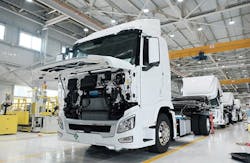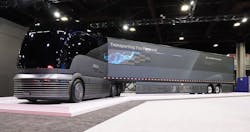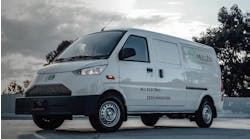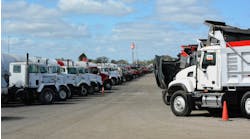Hyundai plans to introduce HD hydrogen truck to U.S. by 2022
Hyundai Motor Co., which is currently testing heavy-duty fuel cell electric trucks (FCETs) in Switzerland, plans on commercializing the hydrogen-powered vehicles in the U.S. starting in 2022. A pilot program could begin in 2021 in California.
The first fleet customers are expected to have 3,000 to 5,000 trucks. That allows Hyundai to gradually build out the much-needed and virtually nonexistent infrastructure. As of Sept. 1, 2020, there were 42 hydrogen stations open in California for light-duty FCEVs, according to the California Fuel Cell Partnership.
Hyundai shipped 10 of its XCIENT Fuel Cell trucks, “the world’s first mass-produced” FCET, according to the company, to Switzerland in July. Forty more should arrive by the end of the year. By 2025, Hyundai expects 1,600 XCIENTs on the road.
The XCIENT is a cabover-style truck featuring a 190-kW fuel cell system with dual 95-kW fuel cell stacks. This provides a range of about 248 miles. There are seven storage tanks for a capacity total of 70 lbs. Refueling takes 8 to 20 minutes, which is comparable to diesel and far shorter than it takes to charge a heavy-duty electric truck. This can take several hours by conventional charging, and even fast charging stations take about an hour to get up to 80% of battery capacity.
“XCIENT Fuel Cell is a present-day reality, not as a mere future drawing board project. By putting this groundbreaking vehicle on the road now, Hyundai marks a significant milestone in the history of commercial vehicles and the development of hydrogen society,” said In Cheol Lee, executive vice president and head of Commercial Vehicle Division at Hyundai Motor. “Building a comprehensive hydrogen ecosystem, where critical transportation needs are met by vehicles like XCIENT Fuel Cell, will lead to a paradigm shift that removes automobile emissions from the environmental equation.”
Hyundai's hydrogen-fueled future was showcased at the North American Commercial Vehicle Show (NACV) in 2019. A concept Class 8 truck called the HDC-6 NEPTUNE was displayed along with the fuel cell and the concept HT Nitro ThermoTech trailer. Hydrogen molecules are more energy-dense than diesel or gasoline, though processing hydrogen into a liquid or gaseous form is currently more costly.
“You have to consider it logically,” said Saehoon Kim, Fuel Cell Center head for Hyundai, at NACV. “If you see all of the constraints and boundary conditions, you’ll come to the conclusion that we need hydrogen fuel cells in commercial vehicles.”
The Seoul-based vehicle maker already has the Nexo Fuel Cell passenger car available (in limited quantities) in California. It has a range of 380 miles. In 2018 the company invested $6.4 billion to branch out from passenger cars and create a richer hydrogen-based ecosystem.
“By showing HDC-6 NEPTUNE, the first hydrogen-only concept for HMC’s commercial vehicles, we will start exploring opportunities in the United States commercial vehicle market,” said Edward Lee, head of Hyundai CV business division. “Furthermore, we are willing to work with other partners to pave the way to establish a hydrogen ecosystem for CV.”
Hyundai and several other companies, from Daimler and Volvo Group , which have a joint venture, to the recently beleaguered Nikola Corp., all are seeking to bring the cost down, from the fuel cells to the fueling network.
Hyundai said a single hydrogen station needs to service 10 trucks per day to remain profitable.
By 2030, hydrogen could provide 1% of the total energy for the U.S., according to the Fuel Cell and Hydrogen Energy Association. The drive for FCETs and battery-electric vehicles is due to increasing regulations calling for a reduction in NOx emissions. The federal Clean Air Act seeks to decrease NOx by 30% by 2030 and another 10% by 2032. To reach this goal, 15 states and Washington D.C. aim to have one in three medium- and heavy-duty trucks sold in their region to produce zero emissions.






